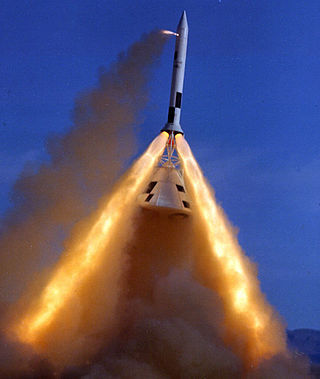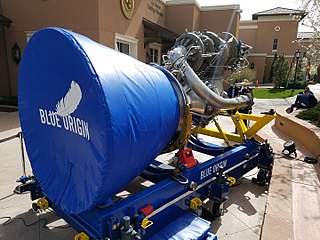Related Research Articles
Human spaceflight programs have been conducted, started, or planned by multiple countries and companies. The age of manned rocket flight was initiated by Fritz von Opel who piloted the world's first rocket-propelled flight on 30 September 1929. All space flights depend on rocket technology; von Opel was the co-designer and financier of the visionary project. Until the 21st century, human spaceflight programs were sponsored exclusively by governments, through either the military or civilian space agencies. With the launch of the privately funded SpaceShipOne in 2004, a new category of human spaceflight programs – commercial human spaceflight – arrived. By the end of 2022, three countries and one private company (SpaceX) had successfully launched humans to Earth orbit, and two private companies had launched humans on a suborbital trajectory. The criteria for what constitutes human spaceflight vary. The Fédération Aéronautique Internationale defines spaceflight as any flight over 100 kilometers (62 mi). In the United States professional, military, and commercial astronauts who travel above an altitude of 80 kilometers (50 mi) are awarded the United States Astronaut Badge. This article follows the FAI definition of spaceflight.

A reusable launch vehicle has parts that can be recovered and reflown, while carrying payloads from the surface to outer space. Rocket stages are the most common launch vehicle parts aimed for reuse. Smaller parts such as rocket engines and boosters can also be reused, though reusable spacecraft may be launched on top of an expendable launch vehicle. Reusable launch vehicles do not need to make these parts for each launch, therefore reducing its launch cost significantly. However, these benefits are diminished by the cost of recovery and refurbishment.

Blue Origin, LLC is an American aerospace manufacturer, defense contractor, launch service provider and space exploration company headquartered in Kent, Washington, United States. The company makes rocket engines for United Launch Alliance (ULA) and other customers as well as manufactures rockets, spacecrafts and heavy-lift launch vehicles. The company was selected as the second provider for lunar lander services for NASA's Artemis program and was awarded a $3.4 billion contract. The company has three rocket engines in production including the BE-3U, BE-3PM and BE-4. The company is working on a fourth rocket engine called the BE-7 which is still under development and when completed will be used on planetary bodies other than Earth.

A launch escape system (LES) or launch abort system (LAS) is a crew-safety system connected to a space capsule. It is used in the event of a critical emergency to quickly separate the capsule from its launch vehicle in case of an emergency requiring the abort of the launch, such as an impending explosion. The LES is typically controlled by a combination of automatic rocket failure detection, and a manual activation for the crew commander's use. The LES may be used while the launch vehicle is still on the launch pad, or during its ascent. Such systems are usually of three types:

A launch vehicle is typically a rocket-powered vehicle designed to carry a payload from Earth's surface or lower atmosphere to outer space. The most common form is the ballistic missile-shaped multistage rocket, but the term is more general and also encompasses vehicles like the Space Shuttle. Most launch vehicles operate from a launch pad, supported by a launch control center and systems such as vehicle assembly and fueling. Launch vehicles are engineered with advanced aerodynamics and technologies, which contribute to high operating costs.

New Shepard is a fully reusable sub-orbital launch vehicle developed for space tourism by Blue Origin. The vehicle is named after Alan Shepard, who was the first American to travel into space and the fifth person to walk on the Moon. The vehicle is capable of vertical takeoff and landings. Additionally, it is also capable of carrying humans and customer payloads into a sub-orbital trajectory.

Vertical takeoff, vertical landing (VTVL) is a form of takeoff and landing for rockets. Multiple VTVL craft have flown. The most widely known and commercially successful VTVL rocket is SpaceX's Falcon 9 first stage.
The Mercury-Redstone Launch Vehicle, designed for NASA's Project Mercury, was the first American crewed space booster. It was used for six sub-orbital Mercury flights from 1960–1961; culminating with the launch of the first, and 11 weeks later, the second American in space. The four subsequent Mercury human spaceflights used the more powerful Atlas booster to enter low Earth orbit.

The BE-3 is a LH2/LOX rocket engine developed by Blue Origin.

The Blue Engine 4 or BE-4 is an oxygen-rich liquefied-methane-fueled staged-combustion rocket engine under development by Blue Origin. The BE-4 is being developed with private and public funding. The engine has been designed to produce 2.4 meganewtons (550,000 lbf) of thrust at sea level.
New Glenn is a heavy-lift orbital launch vehicle in development by Blue Origin, named after NASA astronaut John Glenn, the first American astronaut to orbit Earth. Design work on the vehicle began in 2012; illustrations of the vehicle, and the high-level specifications, were initially publicly unveiled in September 2016. New Glenn is a two-stage rocket with a diameter of 7 m (23 ft). Its first stage will be powered by seven BE-4 engines that are also being designed and manufactured by Blue Origin.

The billionaire space race is the rivalry among entrepreneurs who have entered the space industry from other industries - particularly computing. This private spaceflight race involves sending privately developed rockets and vehicles to various destinations in space, often in response to government programs or to develop the space tourism sector.

Soyuz MS-10 was a crewed Soyuz MS spaceflight that aborted shortly after launch on 11 October 2018 due to a failure of the Soyuz-FG launch vehicle boosters. MS-10 was the 139th flight of a Soyuz spacecraft. It was intended to transport two members of the Expedition 57 crew to the International Space Station. A few minutes after liftoff, the craft went into contingency abort due to a booster failure and had to return to Earth. By the time the contingency abort was declared, the launch escape system (LES) tower had already been ejected and the capsule was pulled away from the rocket using the solid rocket jettison motors on the capsule fairing. Both crew members, Roscosmos cosmonaut Aleksey Ovchinin and NASA astronaut Nick Hague, were recovered in good health. The MS-10 flight abort was the first instance of a Russian crewed booster accident in 35 years, since Soyuz T-10-1 exploded on the launch pad in September 1983. On 1 November 2018, Russian scientists released a video recording of the mission.

Falcon 9 B1046 was a reusable Falcon 9 first-stage booster manufactured by SpaceX. It flew four times between 2018 and 2020 before it was expended during a successful abort test of the Crew Dragon. It was the first Block 5 upgrade to the Falcon 9.

SpaceXCrew Dragon In-Flight Abort Test was a successful test of the SpaceX Dragon 2 abort system, conducted on 19 January 2020. It was the final assessment for the Crew Dragon capsule and Falcon 9 launch system before they would be certified to carry humans into space. Booster B1046.4 and an uncrewed capsule C205 were launched from Launch Complex 39A (LC-39A) on a suborbital trajectory, followed by an in-flight abort of the capsule at max Q and supersonic speed. The test was carried out successfully: the capsule pulled itself away from the booster after launch control commanded main engine shutdown and landed safely.

Blue Origin NS-16 was a sub-orbital spaceflight mission operated by Blue Origin which flew on 20 July 2021. The mission was the sixteenth flight of the company's New Shepard integrated launch vehicle and spacecraft, and its first crewed flight. It carried into space American billionaire and Blue Origin founder Jeff Bezos, his brother Mark, pilot and Mercury 13 member Wally Funk, and Dutch student Oliver Daemen. The flight commenced from Blue Origin's Corn Ranch sub-orbital launch site in West Texas aboard the third flight of New Shepard booster NS4 and the spacecraft RSS First Step, both having previously flown on NS-14 and NS-15 earlier in the year.

Oliver Daemen is a Dutch space tourist who flew as part of the 20 July 2021, sub-orbital Blue Origin NS-16 spaceflight. At the time of his flight he was 18 years old, and is the youngest person, first teenager, and first person born in the 21st century to travel to space. Daemen is a licensed pilot.
RSS First Step is a New Shepard space capsule, built and operated by American spaceflight company Blue Origin. It is the third New Shepard capsule to fly to space, and the first to fly passengers. Its first flight was the NS-14 mission, which reached an altitude of 107 km (66 mi) on 14 January 2021.

Blue Origin NS-18 was a sub-orbital spaceflight mission operated by Blue Origin that launched on 13 October 2021. The mission was the eighteenth flight of the company's New Shepard integrated launch vehicle and spacecraft. It was the second crewed New Shepard launch. The flight, carrying four people including actor William Shatner, launched from Blue Origin's sub-orbital launch site in West Texas aboard the fourth flight of New Shepard booster NS4 and the spacecraft RSS First Step, both having previously flown on NS-14, NS-15, and NS-16 earlier in the year.
Gary Lai is an American aerospace engineer. He was the chief architect for New Shepard, a vehicle developed by aerospace manufacturer Blue Origin for space tourism. On March 31, 2022, he flew on New Shepard's 20th mission to space, NS-20.
References
- ↑ Foust, Jeff (2022-09-12). "New Shepard suffers in-flight abort on uncrewed suborbital flight". SpaceNews. Archived from the original on 2022-09-14. Retrieved 2022-09-12.
- 1 2 3 Richard Tribou (12 September 2022). "FAA grounds Blue Origin New Shepard after emergency abort during launch". Orlando Sentinel.
- ↑ Roth, Emma (2022-09-12). "Blue Origin's uncrewed capsule safely escapes after midflight anomaly". The Verge. Archived from the original on 2022-09-12. Retrieved 2022-09-12.
- ↑ Catherine Thorbecke (12 September 2022). "Blue Origin rocket experiences 'booster failure,' activates abort system during uncrewed launch". CNN. Archived from the original on 2022-09-12. Retrieved 2022-09-12.
- ↑ "Blue Origin's New Shepard rocket, which has carried space tourists, suffers failure". Archived from the original on 13 September 2022. Retrieved 13 September 2022.
- ↑ "New Shepard Mission NS-23 Updates". Blue Origin. Archived from the original on 13 September 2022. Retrieved 13 September 2022.
- 1 2 "'We've experienced an anomaly': Jeff Bezos's Blue Origin rocket fails in uncrewed mission". ABC News. 13 September 2022. Archived from the original on 13 September 2022. Retrieved 13 September 2022.
- 1 2 3 "'We've experienced an anomaly': Bezos's latest Blue Origin launch fails". the Guardian. 12 September 2022. Archived from the original on 14 September 2022. Retrieved 13 September 2022.
- ↑ "Booster failure halts Blue Origin space mission". BBC News. Archived from the original on 14 September 2022. Retrieved 13 September 2022.
- ↑ Chang, Kenneth (2022-09-12). "Bezos' Rocket Crashes; No People Were Aboard". The New York Times. ISSN 0362-4331. Archived from the original on 2022-09-12. Retrieved 2022-09-13.
- 1 2 "Space and Aeronautics Subcommittee Chair Beyer Statement on Blue Origin New Shepard-23 Booster Failure | House Committee on Science, Space and Technology". science.house.gov. Archived from the original on 13 September 2022. Retrieved 13 September 2022.
- ↑ Dunn, Marcia. "Bezos rocket fails during liftoff, only experiments aboard". www.wbtv.com. Archived from the original on 13 September 2022. Retrieved 13 September 2022.
- ↑ Mike Wall Contributions from Elizabeth Howell (2022-09-12). "Blue Origin's New Shepard suffers anomaly during launch, capsule lands safely". Space.com. Archived from the original on 2022-09-12. Retrieved 2022-09-13.
- ↑ Doug Messier (12 September 2022). "New Shepard Research Flight Suffers In-flight Abort; Capsule Lands Safely, Booster Likely Destroyed". Parabolic Arc.
- ↑ "NS-23 to Fly 36 Payloads and Tens of Thousands of Club for the Future Postcards to Space". Blue Origin. Archived from the original on 2022-09-12. Retrieved 2022-09-12.
- 1 2 3 4 5 6 7 8 9 10 "NS-23 to Fly 36 Payloads and Tens of Thousands of Club for the Future Postcards to Space". Blue Origin. Archived from the original on 13 September 2022. Retrieved 13 September 2022.
- ↑ "Biological Imaging in Support of Suborbital Science". Flight Opportunities. Archived from the original on 13 September 2022. Retrieved 13 September 2022.
- ↑ Sheetz, Michael. "Blue Origin says an overheated engine part caused last year's cargo rocket failure". CNBC. Retrieved 2023-03-24.
- ↑ "Blue Origin NS-23 Findings". Blue Origin. Retrieved 2023-06-04.
- ↑ "Blue Origin Says Engine Issue Caused September Rocket Crash". Bloomberg.com. 2023-03-24. Retrieved 2023-03-24.
- ↑ Tan, Huileng. "An uncrewed rocket from Jeff Bezos' Blue Origin failed just over a minute after launch". Business Insider. Archived from the original on 2022-09-13. Retrieved 2022-09-13.
- ↑ "Uncrewed Blue Origin capsule lands safely after New Shepard rocket failure". au.finance.yahoo.com. Archived from the original on 13 September 2022. Retrieved 13 September 2022.
- ↑ Tariq Malik (2022-09-19). "Congress wants transparency on Blue Origin launch failure investigation by FAA". Space.com. Retrieved 2022-09-19.